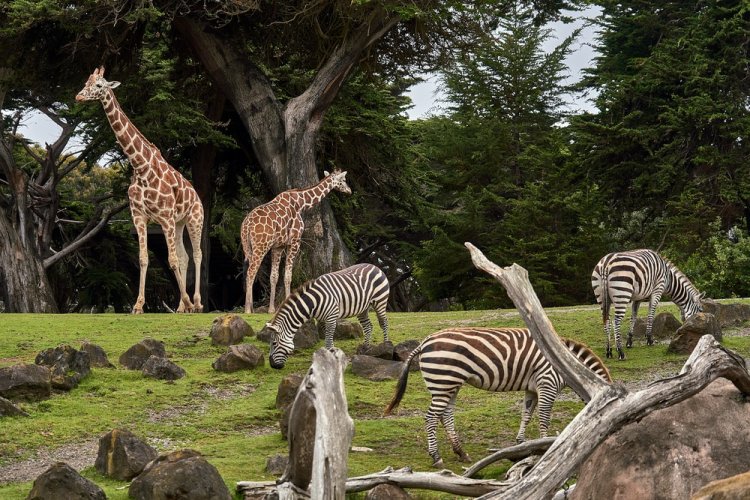Zoo Use 101
Do you think you know how to use your zoo? Think again. After reading Zoo Use 101 you will never be able to look at a zoological park visit in the same way. The result is both a blessing and a curse.

Do you truly see animals at the zoo? A while back, on a visit to the J. Paul Getty Museum in Santa Monica, I overheard a tour guide say the average time spent looking at a work of art in the museum is five to ten seconds per piece. At first this shocked me. At the time I was standing entranced next to Van Gogh’s ‘Irises.’ I envisioned museumgoers not even breaking their stride as they blew past. Then I realized it was the “seer syndrome.” Sadly, most people who came here were seers of art, not observers of art. As it turned out, this was the guide’s point as well.
Unfortunately, in this case ‘seer’ is not as the word implies. In fact, it is the exact opposite. Where most of us picture a seer as psychic or as someone with unique visionary knowledge and wisdom, the seers I am referring to are the tourist-like seers. They are a painfully dominant subspecies in our culture. Tourist-like seers go to the zoo “to see the animals.” And, they certainly do. They glance at each beast, getting no more out of it than if they had stayed at home and thumbed through the Big Picture Book of Animals their kids had been given for Christmas.
Too often these days we use our zoos and museums as a means of fulfilling social obligations. They are classic ways to entertain out of town visitors or to spend perceived quality time with friends and family. In the chaos of socialization, the beauty of the individual exhibit is lost. In order to appreciate both natural and man-made masterpieces, people need to slow down and take time to truly appreciate individual works. In short, they must observe not just see.
THE TRANSFORMATION
Many years ago the San Diego Zoological Society changed me from a seer of animals to an observer of animals. My transformation occurred when I started working as working in the society’s Behavioral Observer Program. My tasks were quite simple. I would watch a single animal for a whole shift, taking note on what my focal subject did. By the end of the first hour I knew I was guilty of years of improper zoo use. I was converted.
In my past life as a seer, I would set out to conquer a whole zoological park in a single day with other members of my species in tow. Sore feet and pricey souvenirs were frequently the end result of the journey. As a seer, I would look at the animals in their cages, read the large print part of some of the signs (name, habitat, diet, etc.), look again at the subject then hypnotically proceed to the next cage. All the while I was socializing with other people. Then this mundane process would repeat. I could cover smaller zoos in a single visit. Boy, did I get my moneys worth?
These days I enjoy acquainting myself with a few new exhibits and visiting friends from past trips. I rarely see more than a small portion of any zoological park in a single day; however, the experience takes over my soul. As an observer, I study each animal and enclosure design, take note and photos for future reference, then relax and watch my quarry. Through the development of familiarity, I take away from my visit a truer knowledge of, and a higher respect for, the animals I have been watching.
SHOE BILL ODYSSEY
For example, during my work, I came to know and appreciate watching the most bizarre of animals. At very first glance, this creature would cause Richard Simmons to become lethargic. The zoological society had asked me to take observation on the first Shoe Bill Stork released on an island at the San Diego Wild Animal Park.
For those of you unfamiliar with this species, let me just say this; Shoebills are large, dull gray, prehistoric looking birds that move somewhat slower than most dead stuff. My first days notes on a 9 am to 1 pm observation period read “11:08 walked three step to ponds edge”, “11:19 drank (duration 35 seconds)”, “12:01 turned away from water”. Try to impress the curator with that insightful piece.
Fortunately, by her third day on the island my target had loosened up (now moving nearly every hour) and I had settled down. The seers would pass us by. Each strained cerebrally trying to figure out why I was staring at the statue of the dinosaur bird.
“Are you sketching it?”
“What is the sculpture of?”
“What do you mean it’s real?”
“No it isn’t.”
“Is it?”
The occasional photographically inclined seer would stare through a telephoto at this photogenic statue. Occasionally, the laid back statue would turn to stare back. The startled seer would launch straight backward. The camera would launch straight forward. Then, the statue would refreeze and I would make my note for the hour discreetly giggling on the ground. Together we would await our next victim. As a seer I would probably still be unaware this species even existed. Thus, how could I appreciate it? I certainly would not ever have found a Shoe Bill amusing had I not given it due time.
NEW PERCEPTIONS
A word of warning here, while it is relatively easy to from reform a seer to an observer; it is impossible to reverse the procedure. You will never be able to suppress being more observant and return to the realm of the seers. This is like trying to stuff a full grown chicken back into its shell. Zoos as a social event will become a living hell!
Seers will find Observers to slow. Even an Observer that is moving at his maximum potential speed of 2.5 frustrated minutes per exhibit will be left in the dust by that average 10 seconds per exhibit of the stealth-like seers. In turn, an observer will be disgusted by the seer’s lack of interest in and appreciation for the individual animals. A Seer will find an Observer to be a know-it-all. An Observer will be resentful of being blatantly humored.
Seers will smack their lips together in an attempt to get an animals attention. Don’t do this! What are you thinking? “Oh, animal 2 million idiots a year subject you to this relentless noise. Now, I am doing it. Come show my friend how special I am. to be your chosen one.” Good grief, give me a break.
An observer will want to slap a smacking seer. The observer must restrain, for seers travel in packs. The observer is a zoological loner. A special person to understand and share quiet time with is hard enough to find in the outside world.
Learning to be more observant is a skill that can benefit mankind in nearly every aspect of his life. Sadly though, many will never even attempt to make the change. A natural avoidance of the unfamiliar will take place. For of the many who hear this essay, most will not have listened.
What's Your Reaction?


































































































